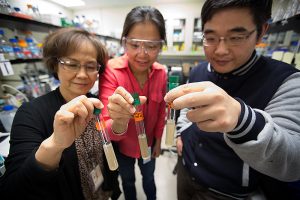Scientists at the U.S. Department of Energy’s National Renewable Energy Laboratory (NREL) have discovered a metabolic pathway that take up CO2 and is then capable of breaking down and fermenting cellulosic biomass to produce biofuels, hydrogen and hydrocarbons. The specific bacteria is Clostridium thermocellum and is among the most efficient bacteria in directly converting cellulosic materials into hydrogen and hydrocarbons biofuels.

NREL scientists Pin-Ching Maness (left), Katherine J. Chou and Wei Xiong hold test tubes containing the bacterium Clostridium thermocellum. (Photo by Amy Glickson / NREL)
Some scientists have found the addition of a form of CO2, known as bicarbonate, into the medium containing the bacterium actually promotes the growth of C. thermocellum, yet its mechanistic details remained a puzzle. This enhanced growth implied the bacterium had the ability to use CO2 and prompted NREL researchers to investigate the phenomena enhancing the bacterium’s growth.
“It took us by surprise that this microbe can recapture some of the CO2 released during growth while they consume sugars derived from cellulosic biomass,” said Katherine J. Chou, a staff scientist with NREL’s Photobiology group and co-author of the new paper “CO2-fixing one-carbon metabolism in a cellulose-degrading bacterium Clostridium thermocellum.” The research is in the new issue of the journal Proceedings of the National Academy of Sciences.
Using carbon isotopes coupled with mass spectrometry analysis, the researchers were able to track how CO2 enters the cell, identify the enzymes critical to CO2 uptake, and how CO2 incorporates into products thereby discovering a new metabolic route that according to the NREL team, was unknown to the scientific community. Many species of bacteria have the pathway in place for CO2 uptake, but before the new research, the pathway was not associated with the role of carbon dioxide assimilation. The pathway enables the bacterium to use both CO2 and organic carbons during its growth.
NREL researchers and their collaborators determined adding bicarbonate increased the apparent carbon efficiency of C. thermocellum from 65.7 percent to 75.5 percent. The finding underscores the metabolic plasticity of the microbe and raises various possibilities on how the bacterium is able to use both organic carbons and CO2 without breaking the rules of thermodynamics in energy conservation. The discovery, according to the NREL scientists, also provides a paradigm shift in the fundamental understandings of carbon metabolism in a cellulose degrading bacterium.
Going forward, the research will focus on redirecting more cellular electrons in support of increased hydrogen production, a key goal of the research.

